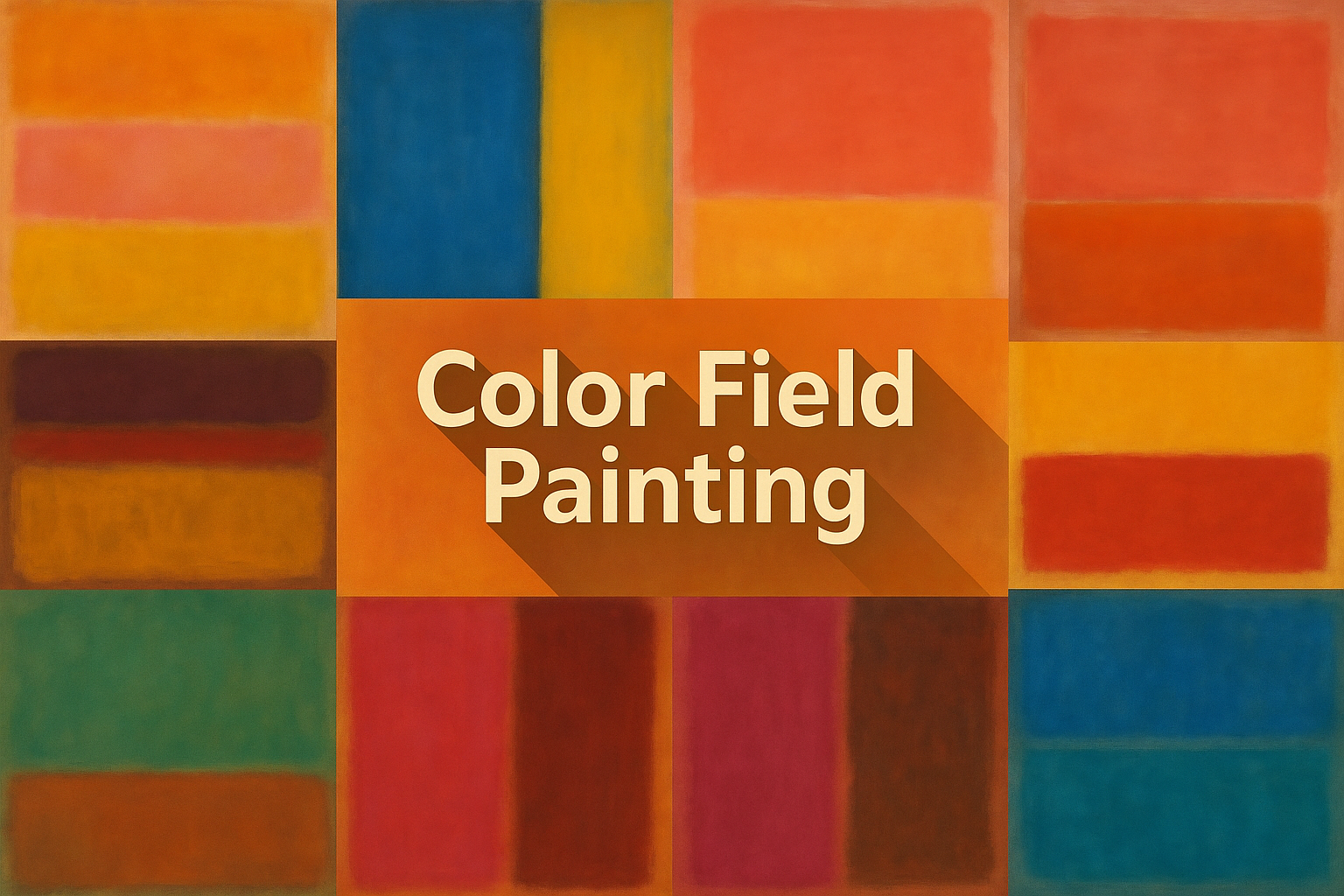
Color Field Painting
Color Field Painting is a type of abstract art that is characterized by large fields of flat, solid color. The color is often applied in a thin, even layer, and the resulting image is usually simple and bold.
AOI thinking about Color Field Painting [+_~]-/
Overview and Quickfacts
Color Field Painting is a style of painting that emerged in the 1940s and 1950s. It is characterized by large fields of flat, solid color, often with little or no texture. The style is associated with Abstract Expressionism, but it can also be seen as a reaction against the gestural style of that movement.
Can understand it also, as:
Abstract expressionism, color painting, non-representational art
Categorize it as:
Impressionism, Modernism
.: Dreaming :.
holds a HAIKU for the art style
:. Thought is power .:
Detailed Description
Color Field painting is a style of abstract painting that emerged in New York City during the 1940s and 1950s. The style is characterized by large fields of flat, solid color and is associated with painters like Mark Rothko, Barnett Newman, and Clyfford Still. Color Field painting was a reaction against the previous generation of Abstract Expressionists, who were more interested in gestural brushwork and expressive content. The Color Field painters were inspired by European painters like Piet Mondrian and Kazimir Malevich, who reduced painting to its essential elements of color and form. The Color Field painters believed that color itself could be expressive, and they sought to create paintings that were purely about color and form. The results are often meditative and calming, with a sense of serenity and peace. Famous Color Field paintings include Mark Rothko’s “Untitled” (1949), Barnett Newman’s “zip” paintings (1949-50), and Clyfford Still’s “1957-D” (1957).
.. beep, beep, beep ..
<START OF TRANSMISSION>
1. Color Field Painting is a type of abstract painting that emerged in the 1940s and 1950s. 2. The term was first used by art critic Clement Greenberg in 1945 to describe work by Helen Frankenthaler. 3. Greenberg associated Color Field Painting with Abstract Expressionism, but the two styles are distinct. 4. Color Field Painting is characterized by large fields of flat, solid color, often with a minimal amount of brushstrokes. 5. The color is often applied in a thin layer, resulting in a luminous quality. 6. Mark Rothko, Barnett Newman, and Clyfford Still are considered the pioneers of Color Field Painting. 7. Rothko's work is often associated with meditative qualities, while Newman's work is often seen as more dynamic. 8. Still's work is characterized by large fields of color with hard-edged geometric shapes. 9. Color Field Painting often has a spiritual or transcendental quality. 10. The style is sometimes seen as a reaction against the emotional intensity of Abstract Expressionism. 11. Color Field Painting is sometimes associated with the Post-Painterly Abstraction movement. 12. The style was also influenced by European movements such as Art Informel and Tachisme. 13. Color Field Painting reached the height of its popularity in the 1960s. 14. Many of the leading exponents of the style, such as Rothko and Newman, died in the 1960s. 15. Color Field Painting has undergone a revival in recent years, with a number of younger artists working in the style. 16. Color Field Painting is sometimes seen as a precursor to Minimalism. 17. The style is also related to Hard-edge painting, Post-Painterly Abstraction, and Lyrical Abstraction. 18. Color Field Painting is often seen as a reaction to the emotional intensity of Abstract Expressionism. 19. The style is sometimes seen as a precursor to Minimalism. 20. Color Field Painting is characterized by large fields of flat, solid color, often with a minimal amount of brushstrokes.
<EOF>
.. robbel bob
Visual Examples from our image gallery
Coming soon, we are so slow .. might never come
Artists, Paintings, and more
(be aware, can be highly speculative)
Artists (be aware, speculation possible):
1. Helen Frankenthaler (1928-2011) 2. Barnett Newman (1905-1970) 3. Clyfford Still (1904-1980) 4. Mark Rothko (1903-1970) 5. Kenneth Noland (1924-2010) 6. Jules Olitski (1922-2007) 7. Morris Louis (1912-1962) 8. Anthony Caro (1924-2013) 9. David Smith (1906-1965) 10. Richard Diebenkorn (1922-1993) 11. Brice Marden (1938- ) 12. Sean Scully (1945- ) 13. Mark Tobey (1890-1976) 14. Sam Francis (1923-1994) 15. Hans Hofmann (1880-1966)
Artworks (be aware, speculation possible)
1. Mark Rothko, “No. 61 (Rust and Blue)” (1953) 2. Clyfford Still, “1957-D No. 2” (1957) 3. Barnett Newman, “Onement I” (1948) 4. Adolph Gottlieb, “Burst” (1961) 5. Helen Frankenthaler, “Mountains and Sea” (1952) 6. Kenneth Noland, “Chevron” (1958) 7. Jules Olitski, “Nocturne Blue” (1965) 8. Sam Francis, “Blue Balls” (1957) 9. Richard Diebenkorn, “Ocean Park No. 67” (1969) 10. Robert Motherwell, “Elegy to the Spanish Republic No. 110” (1966) 11. Clyfford Still, “1957-G No. 2” (1957) 12. Barnett Newman, “The Stations of the Cross LXXIV” (1966) 13. Mark Rothko, “No. 14” (1951) 14. Adolph Gottlieb, “New York” (1964) 15. Helen Frankenthaler, “Circles in a Square” (1959)
Epoch
The time period of Color Field Painting is generally considered to be from the 1940s to the present.
AI ART RESSOURCES (AKA, well Tools)
Helping tools -> predefined search links on other pages:











